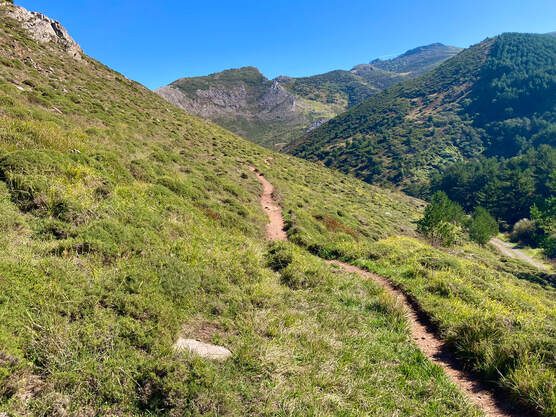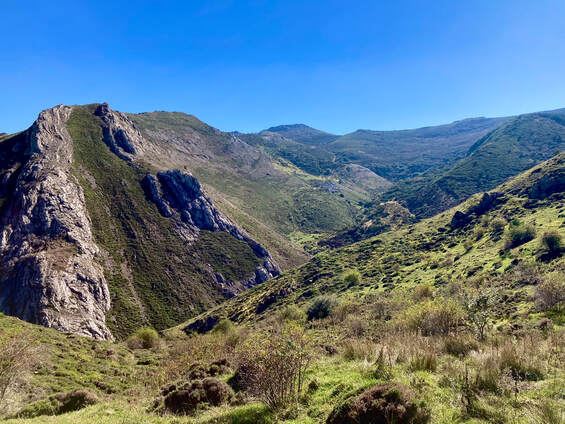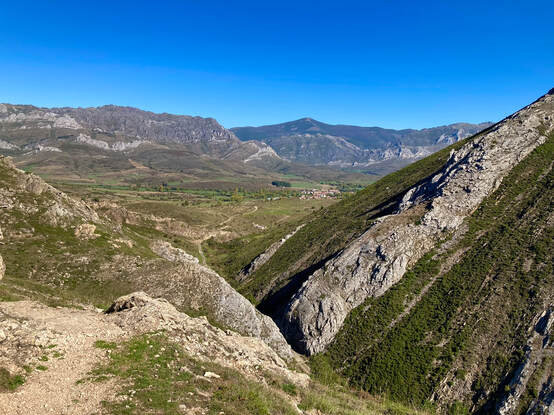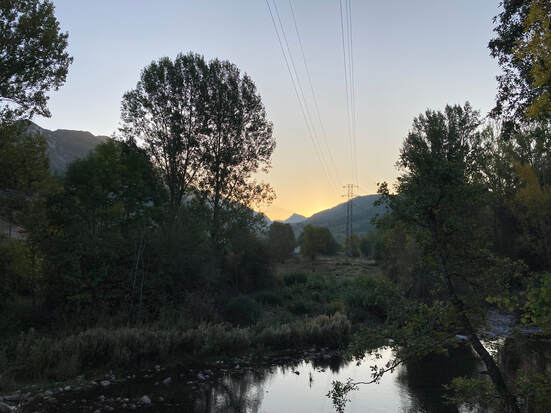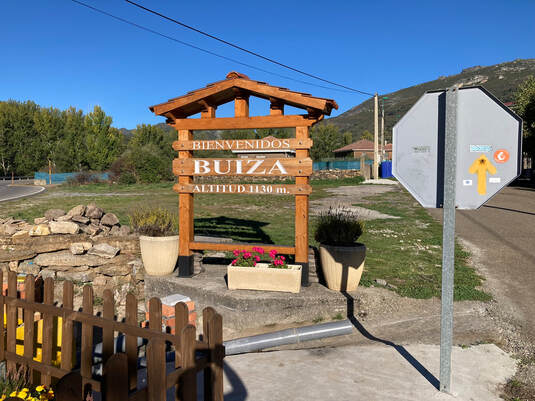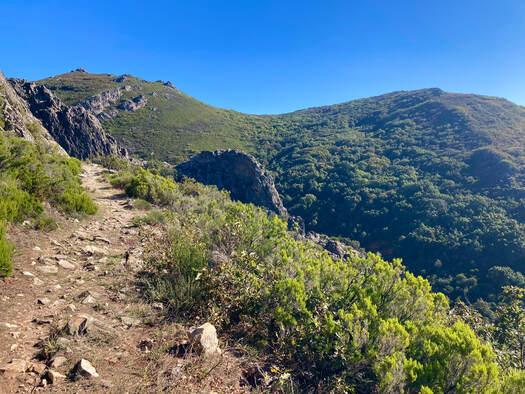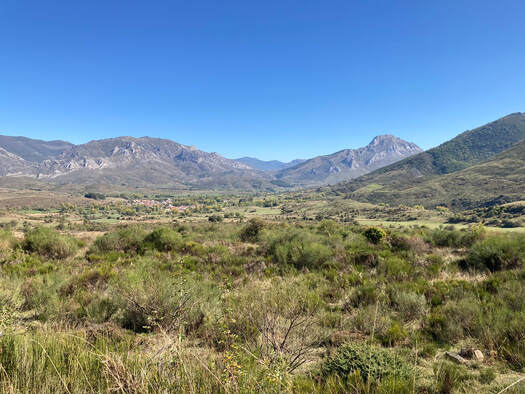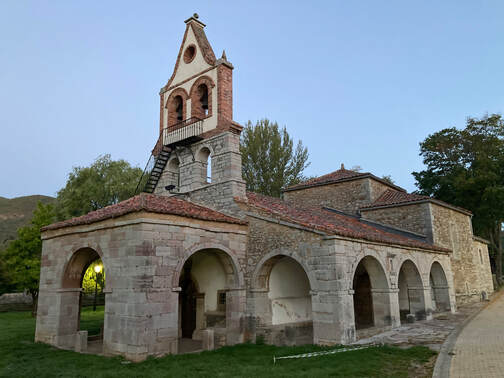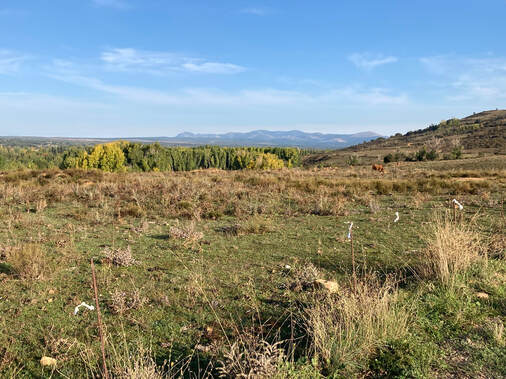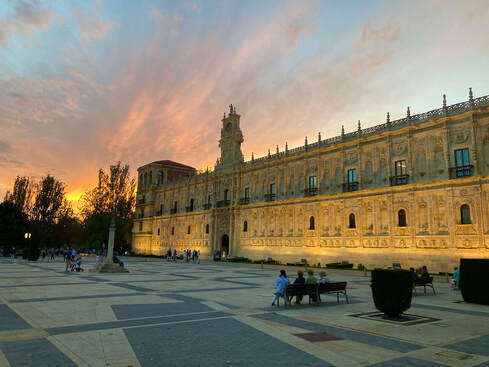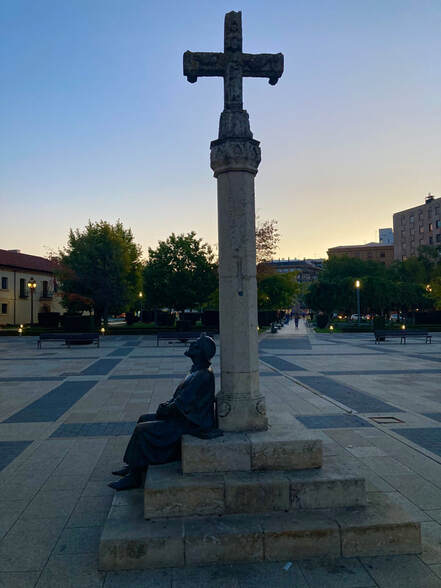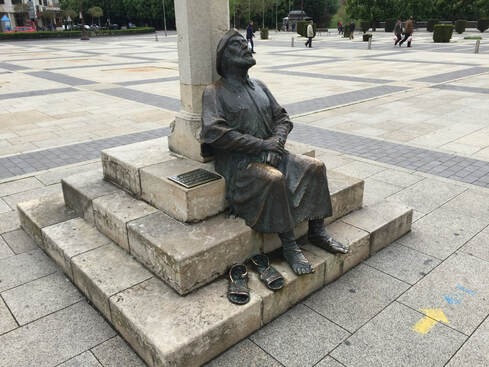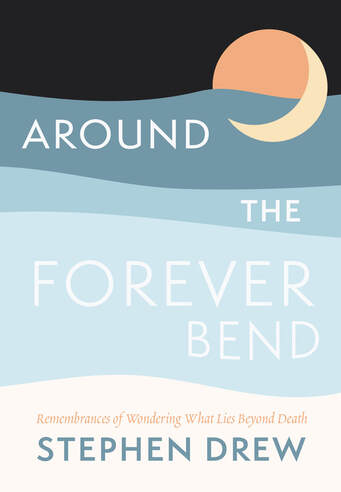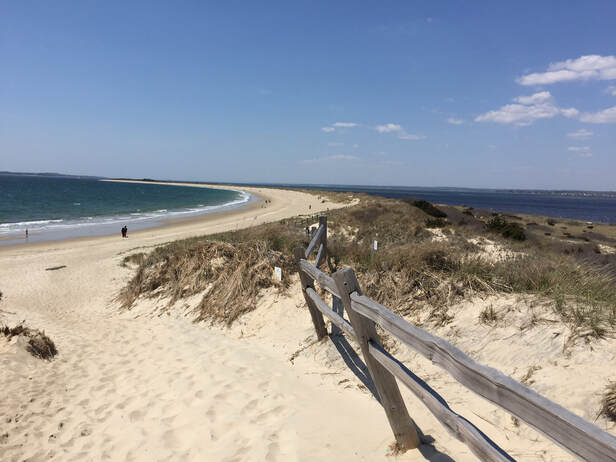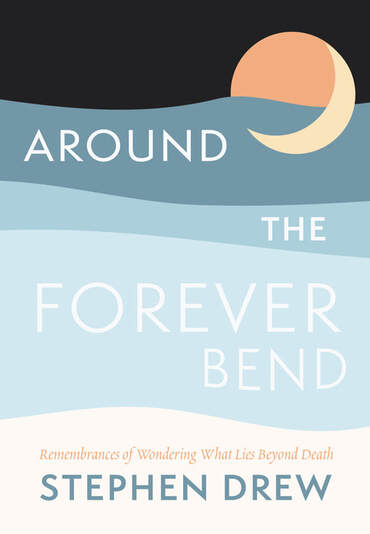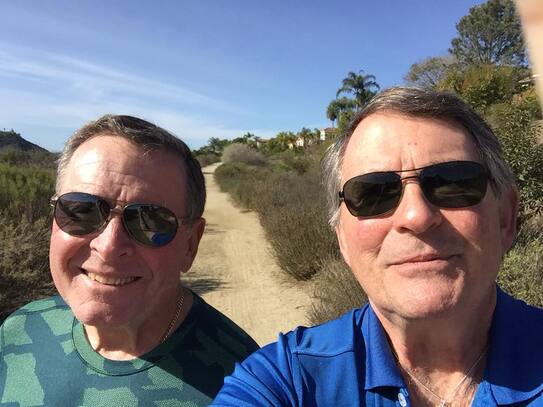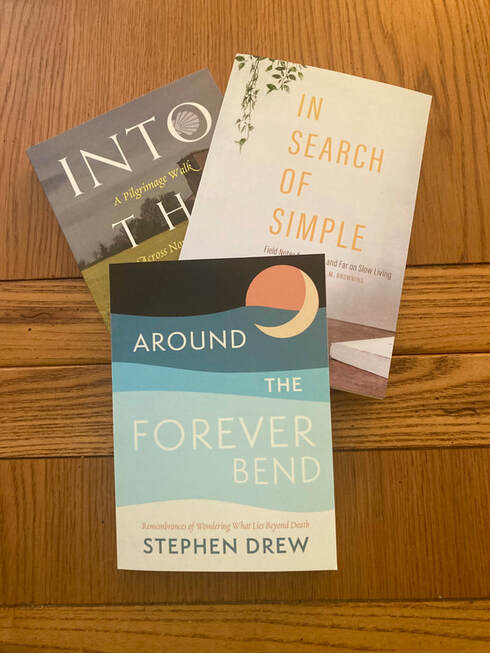|
A note for readers: This is the fourth in a series of articles intended to describe my experience of walking two of the many pilgrimage routes that make up Spain’s Camino de Santiago. Although I documented those experiences on Facebook as they were unfolding in October 2023, this is a much deeper look into their implications. Should you need to review the previous articles for context, please scroll down. ***** The pace of this climb is glacial. There is no choice. Only one step exists, and that is the one I’m now taking. The trekking poles are helpful as they enlist my upper body in the effort to move forward and upward, but my legs and lungs burn. Where the climb finds its summit is unknown to me, for it can’t yet be seen, and I wish it to remain so despite having an informative route navigation app loaded into my phone. It’s better this way. Let it be a mystery like this whole pilgrimage needs to be, like the darker aspects of my past that currently occupy my mind, like the sense of calling that brought me to this in the first place, and like my abiding love for this kind of effort. A mystery. Each time I’ve seen Guilherme pause, I have paused too, but now I see him drop his pack and retrieve a water bottle. I allow myself to catch up and drop my pack as well. “Everything okay, mi amigo?” I ask. He nods. “I’m fine. Our pace is good, no?” “It’s perfect.” Looking around at the expansive view, I take a drink of water. “This place is perfect too, huh?” “It is,” he says, “fantastic.” I’ve noted before that this is his favorite word in English. He describes many things this way: coffee, how he slept, a church, a sandwich. He always means extraordinary. “Yes,” I say. “It is fantastic indeed.” Guilherme shoulders his pack and returns to the climb. I wait for him to get a good lead before setting off myself. Time has become distorted and therefore irrelevant, this a result of what I would describe as a kind of self-hypnosis. I have no idea how long it’s taken, but finally we pass through a saddle between two peaks and this first major climb of the San Salvador route is done. We pause for a long while, resting. My friend offers a triumphant smile and tosses me an orange. It feels as if I’m standing on another planet in some lonely outpost of the galaxy, as if I now know what the Moon might be like if it had scrub brush and grasses and air. The remaining 6-kilometer trek to our destination of Poladura de la Tercia consists of a descent in varying degrees, a few minor climbs, and a fair amount of relatively flat walking near our finish. I can’t get over the weather. I packed some cold-climate provisions out of respect for how quickly conditions can change in the mountains, much as I had done before climbing New Hampshire’s Mount Washington a few years back. But Spain has been experiencing a very warm October, and even at these high elevations, the midday temperatures are in the 80s. I’ve gotten into the habit of removing the lower legs of my zip-off pants around noon. After our long walk across hilly pastures framed by magnificent granite peaks, my companion and I are both severely leg-tired as we arrive in Poladura. We claim our bunks in the municipal albergue, and, after tending to our showers and laundry chores, find our way to an inviting, rustic café located in a nearby hotel. It’s mid-afternoon, so we assume they’ll be serving only drinks and snacks, but our old friend Ramon and two other Spanish pilgrims greet us there with the happy news that a three-course meal is available. As we hungrily tuck into our food, Guilherme declares it all to be...fantastic. Later, as evening sets in, I take a walk alone around the village. The subdued tones of the day’s remaining light usher in a slight chill as I stroll along and consider the stages of the pilgrimage just ahead. Tomorrow, because he soon needs to return to work in Portugal, Guilherme plans a 31-kilometer day from here to Campomanes, a brutally difficult trek of wildly varying mountain walking which begins with a stout climb just outside of town. As part of my advance planning, I had elected to halve this inordinately severe stage by stopping for the day after 14-kilometers in Pajares where he and I will part. These sweet goodbyes are an enduring feature of pilgrimage, because while companionship is often a part of the walk, what’s best for the pilgrim’s spiritual intention remains primary, and for me this return to the solo walk serves that notion best. I may not yet fully realize it, but there is something ahead I must face alone. Next, an early morning climb, sunrise in the Cantabrians, a fond farewell, and moments of penitence.
A note for readers: This is the third in a series of articles intended to describe my experience of walking two of the many pilgrimage routes that make up Spain’s Camino de Santiago. Although I documented those experiences on Facebook as they were unfolding in October 2023, this is a much deeper look into their implications. Should you need to review the previous articles for context, please scroll down. ***** Day two on the Camino San Salvador begins as do all my days, with a prayerful contemplation, a consideration of what lies ahead. I remain curiously ambivalent about whether to saunter alone today, so I’ll just leave it up to the Camino. Walking out into the morning’s dark, breezy chill, I head north along the main street. It’s not long before I see a shadowy form ahead standing with a pack at his feet. Our walk today brings us from La Robla to the village of Buiza, some 14 kilometers away. From this last outpost before the wild landscapes of the Cantabrian Mountains are revealed, Guilherme and I will launch into the first big climb of the route. The weather is predicted to be perfect, beginning clear and cold with a warm, sunny finish in the mountain town of Poladura de la Tercia, 24 kilometers from La Robla. Our immediate plan, though, is to move quickly through the 11-kilometer valley walk to La Pola de Gordo where coffee and breakfast await. Our shared accommodation for the coming evening is a small municipal albergue where the policy is first come, first served ̶ ̶ hence our dark, early departure. Guilherme speaks his native Portuguese and fluent Spanish, but only serviceable English. This limits our conversations to some degree, which for me makes him a great pilgrimage mate. I’d committed to making my time on the San Salvador a deeply contemplative experience, but the difficult terrain involved in the mountain sections had given me pause about going it alone. This is a route where a very long time indeed could pass before anyone might come along should I become injured or disabled. The Camino, as we pilgrims love to say, does provide. By the time we arrive at the café in La Pola de Gordo, we’re famished. Our brisk pace has put us ahead of the expected arrival time, so in addition to pastries and a generous, filling portion of tortilla (think egg and potato quiche), we linger for a while over several café con leches. Finally, in the wordless way of pilgrimage companionship, we glance at each other, nod, shoulder our packs, and light out of town heading north. Along the way to Buiza, we make the acquaintance of Ramon, an older pilgrim from Cadiz who is just donning his pack after taking a rest stop. He speaks only Spanish, so I’m left out of the conversation between him and Guilherme. His energy is warm and kind, but his pace is quite brisk, and he is out of sight around a bend in the road in no time. This prompts a conversation between my companion and me about our pace for the climb that lies ahead. We seem to be of the same mind, agreeing that a slow, deliberate approach will serve us best. It appears that neither of us has studied the ascent profile of the climb from Buiza, not out of avoidant fear, but out of a place of acceptance. The unknown road lies before us and we must walk it. Such is the simplicity of pilgrimage. As we emerge from the close, lush surroundings of the valley into the town of Buiza, the landscape of the Cantabrian Mountains opens before us and we step into a new world. Pastures rise sharply from the edges of the town and lean onto the craggy rock of the peaks that surround the place. At first, the scale of it all is overwhelming. It’s just so big. The roadway we’ve been walking gives way to a dirt track, and after we pass through a gate at the far end of town, we follow its rising, diagonal course across an immense pasture. We stop frequently throughout this early climb to look back at the ever-changing views of the valley and the town below. The midday sun is strong, the air is dry and very warm, this morning’s breezy chill now but a distant memory. I feel enveloped, held by these vast surroundings. From here the grade launches as the path becomes a rocky, dusty affair. We continue a slow and deliberate, almost creeping pace, as a gentle, cooling breeze offsets the day’s heat and the exertion of the climb. Guilherme is ahead of me by 50 meters or so, each of us claiming our very own path, finding the perfect blend of privacy and safety. At last, my thoughts yield to the spiritual intention I’ve carried from home. While the mountains persist in revealing new heights, the climb proves relentless, and the inner shadows meet their earthly reflection of strain and discomfort. This is pilgrimage. Next: Mountains and valleys. A note for readers: This is the second in a series of articles intended to describe my experience of walking two of the many pilgrimage routes that make up Spain’s Camino de Santiago. Although I documented those experiences on Facebook as they were unfolding in October 2023, this is a much deeper look into their implications. After 7 kilometers of urban-street walking, the Camino San Salvador transitions to a wide track of dirt and gravel at the northern limits of suburban Carbajal de la Lengua. The landscape is austere but lush, the silence noticeable under a perfect, blue sky as the warmth of the day makes itself known. Today’s destination is the Camino way-station town of La Robla, some 25 kilometers from Plaza San Marcos in Leon. At last, the rhythm of the walk settles, my stride is full and relaxed, the pack barely felt as the extension of my body it is rapidly becoming. I feel as free as one could even dream, a walking pilgrim once again. The wider track narrows to a single path as it courses through the gently undulating landscape, the color of its sandy dirt now a warm, buttery yellow and with just enough gravel to make a hearty crunching sound underfoot. To my right just ahead on the inside of a gentle curve, I spot a weathered wooden bench under a shade tree, and realize I’ve not yet stopped to rest. I drop the pack beside the bench, lean my trekking poles against the pack, and take a seat as I slip my shoes off for a while to massage my feet. An easy breeze is in the air, and quiet continues to surround me. After a few moments I hear footsteps approaching. A stocky, lumbering fellow who appears to be about my age rounds the curve and spots me right away as I raise my hand to greet him. “Hola, buenos dias, buen Camino!” I say. I’ve found that when I meet a fellow pilgrim on the road, it often begins with a simple act of concern, an offer of help. Sure enough, stopping before me, he replies in kind, and, having noted my accent, asks in somewhat serviceable English if I am okay, if there is anything I might need. I thank him and assure him I’m well. From his pants pocket, he extracts a white handkerchief with a colorfully patterned band at the edge and wipes his face and neck as he asks if I’m heading to La Robla. I reply that I am, and now satisfied that I’m in good shape, he wishes me buen Camino once more and continues on his way. Noticing his pace as he does so, I realize I’ll likely catch up to him later. I take more time resting, drinking water, and snacking, feeling somewhat ambivalent about the prospect of encountering this pilgrim again any time soon. I’d envisioned a solitary walk today, but I’m experienced enough at pilgrimage to know this may not be the way it’s meant to go. I shoulder the pack, grab the poles, and resume walking at a leisurely pace. After a little while, I can see enough of the path ahead to note I’ll be scaling a ridgeline in a series of sharp ascents and descents. I can also note that my fellow pilgrim is a couple of hundred meters ahead, laboring in a slow, deliberate climb. On the ground not far in front of me, I see a white handkerchief with its distinctive, brightly colored band. I pocket it and move on toward the meeting I now know is inevitable. I catch up to him as he rests at the top of yet another climb. He smiles as I present him with his handkerchief and introduce myself to Guilherme from Portugal. Without any formal agreement, we walk loosely together for another 10 kilometers or so, separated variously by a few steps or a hundred. Talking is minimal but meaningful, and we agree on a slight detour to a café for some food and rest. In many ways, he reminds me of a German fellow I walked with on my first Camino, a man who respected silence as a way of pilgrimage. Sitting at an outdoor table, we cover the usual ground in conversation. How we came to be on the route, and what our intentions for the walk might be. We discuss our lives at home, our work, and our families. Turns out he is the CEO of a company manufacturing a large share of the world supply of cork bottle stoppers. “My life is about the cork,” he says, shaking his head a bit and smiling. He notices the imitation cork of my trekking pole handles, and can’t help but comment. “You know that’s not real,” he tells me, now grinning. “Cheap bullshit polymer.” I can see we share a similar sense of humor if not a passion for genuine cork. We leave the café and walk more closely for the remainder of the day. Arriving in La Robla, we pause on the main street in front of my accommodation for the night. He says his is a little farther on, and tells me he will wait for me on the street in the morning until 7:30 if I care to join him for tomorrow’s walk into the Cantabrian Mountains. I suggest we exchange phone numbers in case something comes up, and we part for the day. After checking in, showering, and rinsing out today’s clothes, I walk about town for a while and consider if I really want Guilherme’s company for this first ascent. There is a tension between my predetermined preference, and what may be best. Again, I’m ambivalent, so I’ll sleep on it tonight and see how it looks in the morning. Next, the first climb. A note for readers: This is the first in a series of articles intended to describe my experience of walking two of the many pilgrimage routes that make up Spain’s Camino de Santiago. Although I documented those experiences on Facebook as they were unfolding in October 2023, this is a much deeper look into their implications. ***** It always begins in the mind, the place where the influence of the spirit meets the good labor of the flesh. A thought comes to suggest it’s time for another saunter. This is the idea: Two walks, two intentions, minimal distractions. My beloved Spain and its Camino are calling me once more. Surely some good must come of this. A route comes to mind, and on the heels of that a gentle suggestion arrives from a friend about a different kind of route. The heart sings. And now it seems there are mountains involved. With the mountains comes the fear, the unknown. And just like that, all the elements of a pilgrimage are in place. I had trekked across another route of the Camino once before, walking 500 miles over 39 days from southern France to the Atlantic coast of Spain. That was the outer journey, a mere reflection of the inner one. As the result of them both, everything had changed. I’d been delivered, deposited if you will, into another way of life. A book was born of that one, and in 300 pages and almost 100,000 words, I was never able to fully articulate just how it all came to be. Some things, it could be said, need to remain silent and secret. But that was then, and life moves forward. The Camino San Salvador begins at the base of a statue found on Plaza San Marcos in Leon, Spain, depicting an exhausted medieval pilgrim at rest. The pilgrim faces the Parador Hotel, one of a chain known for an utterly absurd level of luxury. God, how I love irony. From here the route maintains a northerly course, which, over six uniquely difficult stages, arrives at its end point, the Catedral de San Salvador in the beautiful city of Oviedo. Here again, I refer to the outer journey, the mere reflection. I’ve come to believe the inner pilgrimage is best undertaken with an intention in mind ̶ ̶ a movement of thought toward one’s center, something to ponder, resolve, or surrender. Could be anything, really. The pilgrimage as an extension of the Divine will have its way with whatever is offered. My intention for the Camino San Salvador was to probe the depths of the shadows, the darker aspects of how I have lived through nearly seven decades. It was to be undertaken with an attitude of quiet penitence, an act of walking in contrition for the times in this life when I’ve missed the mark, or, as they say in archery, when I have sinned. The outer route promised the perfect expression of this with the hard and dangerous work of climbing and descending nearly 10,000 feet over the length of the route, all the while surrounded by the breathtaking, rugged scenery of the Cantabrian Mountains. Largely isolated, and silent save for the wind, it’s the kind of place to go when the time has come to remember, reflect, and sort some things out. On a crisp and chilly autumn morning, I left my hotel in Leon and walked the short distance to a nearly deserted Plaza San Marcos just as night was yielding to the dawn. The pack felt good on my back, and my heart was full of optimism along with a good measure of excitement as I made my way to the pilgrim statue. Sitting at its feet, I prayerfully centered myself for what lay ahead both inwardly and along the road, that I may honor my intention in each step that would follow. It’s always good to begin this way.
I’ve come to love the poetic moments that Grace will so often allow in this life we live, moments when we come to know there is an intelligence beyond our understanding looking after things, silently expressing its perfection. As I took my first steps away from the statue, I knew I was not alone, for the date was October 4... the 13th anniversary of my son Keith’s death by suicide. Onward. Next: The walk to La Robla and beyond into the Cantabrian Mountains. The pilgrim statue on Plaza San Marcos in Leon, Spain I am envisioning a moment in the not-too-distant future. In it, I’ll be standing on a gravel and dirt road just north of Leon, Spain ̶ ̶ a road that begins at the feet of my old pilgrim friend pictured here, and leads toward the town of La Robla as the first stage of the Camino San Salvador. I will have been walking for a few hours. No one else is around and it is silent, the bustle of Leon only an echo in memory. Surrounding me are some foothills, light swells in the land, nothing too impressive. Impressive comes in another day or two in the form of the Cantabrian Mountain Range.
In this future moment of mine, I note how very different this experience will be from my last walk along a pilgrimage route. In time, seven years have passed. It seems so much has changed. And yet here I am again, walking in this place that has always reminded me of time’s circular shape, walking over the ancient ground, walking through the birthplace of this life I now live as one who writes and thinks and wonders. The old conundrums are with me again: the tension between time and what it contains, the way things seem to be, the way things are, and the way they shall be. And so now, alone during this envisioned brief interlude early along the Way, I am to pause and place my intention, as silent and secret as it is dark, into the steps not yet taken, onto the abiding road that awaits, for this is the way of pilgrimage: to walk on unknown ground in faith, to allow the inner journey to reflect outward, and most of all to listen for the road’s steadfast and trustworthy reply. The road is wise and holy. The road is beautiful. The road is life. Here is a prayer I can offer aloud: May I find a way forward. May I ascend beyond. May the saints speak their Word and carry me ever homeward. Amen. Buen Camino. I’ll be in touch. This quiet lyrical essay that ponders the nature of death and therefore life, released a little over a month ago. Since then, I've received some lovely comments about how it's landed in reader's hearts. I've always felt this book has a thing to say, and would hope that it finds its way to those who may benefit.
If you've read this book and found it worthy, I'd be most grateful were you to leave the best possible rating and review on Amazon, Barnes & Noble, and (if you're on it) Goodreads. It really does help in directing eyes to the pages. From my latest, Around the Forever Bend, Remembrances of Wondering What Lies Beyond Death, page 49... "The first thing is to climb the steep berm of the dune, following the sounds from the surf beyond. At the top, it's not unusual for those who've never been here, or who, like me don't come often, to stop and pause as one might when entering a church sanctuary. From here I can see the entire crescent of the beach: the Atlantic, the sand, the grasses, the hook of the point a mile distant." Today, Around the Forever Bend, Remembrances of Wondering What Lies Beyond Death, is officially published! I'm grateful beyond measure for this quiet little book, a book that revealed itself to me in its own good time. As it made the rounds of early readers as a manuscript, I was told a few times that it was helpful, comforting, and thought provoking. From my humble place as its writer, these have been my highest aspirations for it. I pray this continues for many more who read.
In this lyrical essay, the narrative of remembrance, poems, and the beauty of dreams mingle. Journey from a child's view of life's end to a perspective much closer to that end, and something as familiar as an old friend comes into focus, greets us, and teaches us its ways. Around the Forever Bend can be ordered online or in-person from your favorite local bookseller, or online from the publisher, Barnes & Noble, or Amazon. It's also available in all e-book formats. Should you experience the book as a worthy read, please know a positive rating and review at Amazon and/or Goodreads helps greatly in advancing its reach into the world. Frederic (Rick) Ludwig, Captain, USN (Ret), pictured on the left, passed suddenly on Sunday, April 16, 2023 in San Diego in the company of those who mattered to him most, his family. Rick had several titles in life: Son, brother, husband, father, grandfather, friend. He was also a legendary naval aviator (call sign Wigs), a veteran of some 300 combat missions over Vietnam, and qualified on a laundry list of fixed and rotary-wing naval aircraft. He even had a stint as the Commanding Officer at Top Gun. For more on his military career, check out this interview. To borrow some aviation slang, Wigs lived life with the burners on until the landing...the day before his death, he was belatedly celebrating his 78th birthday with his family over some pizza. Way to go.
His younger brother is my dear friend, Bill Ludwig. These two bonded deeply and early in life. Raised in the small town of Woodbridge, Connecticut, their childhood was like something from the pages of Boys’ Life magazine. Every account of it I heard from either of them was nothing short of idyllic. Being raised as best friends makes for a connection that only deepens over time. I think it fair to say that to the end, the company they preferred was each other’s. Living on opposite sides of America did nothing to deter that preference. In addition to frequent visits, they spoke on the phone daily, and they’d just made plans to cross the Atlantic together on a cruise from Spain this coming autumn. Over the past few weeks, Rick had experienced some vague health issues. Bill and I spoke of this a few times, and he thought that maybe despite some plans to the contrary, he ought to go to California instead. It quickly became an imperative...as I see it, a calling. Sudden. Urgent. Go now. Two days later, they were hanging out in San Diego. Rick’s birthday celebration followed with nothing foreboding on the horizon. Next day found Bill at his brother’s side as he passed. How else to see this but as an act of Grace, to see them as being held in the hand of something so great, so perfect? As for me, I’m done with coincidence and chance. I count myself among Bill’s friends, and we are legion. There is something about this guy. I know we’ll hold him close each in our own way. I’m certain he will feel this almost as deeply as his loss. We are never alone. With you, brother. Around the Forever Bend, Remembrances of Wondering What Lies Beyond Death, my latest offering, will be publishing (at last)on May 23, 2023. Originally scheduled for August of 2022, something told me at the time it wasn't quite there yet. Glad I listened. Glad also to have such an understanding publisher.
From the book description: We are the only beings on earth who intrinsically wonder about our own end. But is there a way to elicit more elegant, gentle questions? Maybe something finer can be imparted, a way to bring the inevitable grief this life holds, into the love it really is. In this lyrical essay, poetry and the beauty of dreams mingle with remembrance. Journey from a child's view of life's end to a perspective in time much closer to that end, and something as familiar as an old friend comes into focus, greets us, and teaches us its ways. Around the Forever Bend is available online for preorder from the publisher, Amazon, and Barnes and Noble. Of course, ordering from your local bookseller is a pretty great thing...just tell them "it's on Ingram," and they'll know what to do. My memoir, Into the Thin, as well as the more recently published anthology, In Search of Simple (to which I contributed along with a dozen terrific writers), are currently available from the same sources. |
|
